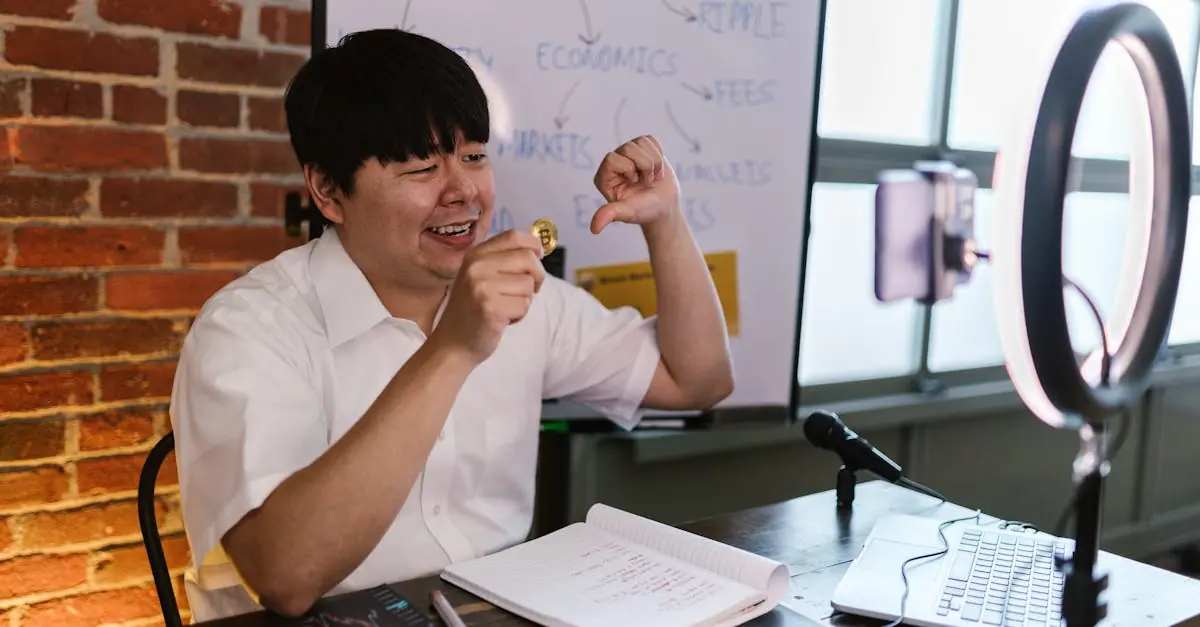Table of Contents
ToggleBlockchain isn’t just a buzzword tossed around at tech conferences; it’s the backbone of a digital revolution. Imagine a world where transactions are secure, transparent, and virtually tamper-proof. Sounds like something out of a sci-fi movie, right? Well, it’s not. With blockchain technology, this futuristic vision is already here, and it’s changing the game for businesses and individuals alike.
In this tutorial, readers will uncover the mysteries of blockchain, from its fundamental concepts to its real-world applications. Whether you’re a curious newbie or a seasoned techie looking to brush up on your skills, this guide will break it down in a way that’s easy to digest—no jargon-filled nonsense. So grab your virtual toolkit and get ready to dive into the world of blockchain, where the only thing more secure than your transactions is the humor sprinkled throughout this tutorial.
Understanding Blockchain Technology
Blockchain technology acts as a decentralized digital ledger, enabling secure and transparent transactions. It forms the backbone of cryptocurrencies while presenting various applications across different industries.
What Is Blockchain?
Blockchain consists of a series of linked records called blocks. Each block stores transaction data, a cryptographic hash of the previous block, and a timestamp. This structure ensures that once data is recorded, it cannot be altered without consensus from the network. Many view blockchain as immutable, providing a permanent and verifiable record of transactions. Its decentralized nature reduces the risk of single points of failure, making it resilient against fraud and hacking.
Key Features of Blockchain
Blockchain boasts several defining characteristics that contribute to its effectiveness. First, decentralization replaces traditional intermediaries, allowing peers to interact directly. Next, transparency promotes trust, as all participants can view transaction histories. Security plays a crucial role; cryptographic principles protect data against unauthorized access. Also, immutability ensures that once data enters the blockchain, it remains unaltered. Finally, consensus mechanisms validate transactions through distributed agreement, enhancing overall reliability.
Getting Started with Blockchain Tutorial
This section focuses on the essential steps and tools for initiating blockchain development. Familiarity with the right environment and tools simplifies the learning curve.
Setting Up Your Development Environment
Choosing the correct development environment enhances blockchain project efficiency. Install a code editor, such as Visual Studio Code or Atom, to work comfortably on your scripts. Setting up Node.js enables seamless management of JavaScript runtime tasks. Configuring a local blockchain, like Ganache or Hardhat, provides a testing ground for smart contracts without incurring costs. Installing Git facilitates version control, allowing easy collaboration on projects.
Essential Tools for Blockchain Development
Utilizing appropriate tools streamlines blockchain development. Truffle Suite simplifies smart contract compilation, deployment, and testing. Remix IDE offers an intuitive interface for writing, testing, and debugging Solidity contracts. Web3.js establishes a connection between decentralized applications and Ethereum nodes. Metamask browser extension allows for secure Ethereum wallet usage and transaction signing. Blockchain explorers, like Etherscan, provide easy tracking of transactions and contract interactions.
Fundamentals of Blockchain Programming
Understanding blockchain programming begins with smart contracts. Smart contracts are self-executing agreements coded on the blockchain. They automate processes by enforcing rules and agreements without intermediaries. For example, when conditions are met, the contract executes specific actions like transferring funds. This functionality enhances trust and reduces costs, making them essential in decentralized applications.
Regarding programming languages, several options cater to different blockchain needs. Solidity, primarily used for Ethereum, enables developers to create complex smart contracts. JavaScript remains popular for building frontend applications that interact with blockchain. Python also offers robust libraries, ideal for data manipulation and smart contract testing. Other languages like Go and Rust contribute to the development of blockchain platforms, ensuring a diverse ecosystem. Each language provides unique advantages, allowing developers to choose based on project requirements and personal preferences.
Building Your First Blockchain Application
Creating a blockchain application involves several straightforward steps. Developers can start by mapping out the application’s logic, defining how users will interact and what data needs to be stored.
Step-by-Step Guide
- Identify use cases for your blockchain application to streamline development processes.
- Choose the appropriate blockchain platform such as Ethereum or Hyperledger based on your project’s requirements.
- Set up development tools, including Truffle Suite and Ganache, to facilitate smart contract development and testing.
- Write smart contracts and utilize Solidity for Ethereum applications, ensuring they meet necessary specifications.
- Test contracts through a local blockchain environment, confirming functionality before deployment.
- Deploy smart contracts onto the main blockchain, making them available for users.
- Integrate the application with front-end interfaces, enhancing user experience across devices.
Best Practices for Development
Implementing best practices in blockchain development promotes efficiency. Start by ensuring code is modular for easier updates and maintenance. Focus on security by following protocols for smart contracts to prevent vulnerabilities. Testing must occur across various scenarios to identify and rectify potential issues. Documentation aids in the understanding and future development of the code. Employ version control systems like Git to manage changes and collaborate effectively. Lastly, stay updated on blockchain trends and technologies for continual improvement in your applications.
Advanced Topics in Blockchain
Advanced topics in blockchain technology deepen understanding and application, focusing on critical areas such as scaling solutions and security considerations.
Scaling Solutions
Scaling solutions address the need for blockchain networks to handle increasing workloads without sacrificing performance. Layer 1 solutions improve the base protocol by optimizing the existing blockchain; examples include Bitcoin’s Segregated Witness and Ethereum’s upgrades. Layer 2 solutions, like the Lightning Network and Plasma, function on top of Layer 1, enabling faster transactions and lower fees. Sidechains also allow for experimentation and functionality outside the main chain, fostering innovation. Each approach presents unique benefits, making careful selection essential based on specific project requirements.
Security Considerations
Security considerations in blockchain are paramount to maintain trust and integrity. Smart contracts require thorough audits to prevent vulnerabilities and attacks, given their automated nature. Decentralized applications need to implement robust cryptography to protect user data and ensure secure transactions. Regular updates and patches address potential security flaws, adapting to emerging threats. Understanding the shared responsibility model between developers and users is crucial for minimizing risks. Awareness of possible attack vectors, such as Sybil or 51% attacks, ensures proactive measures for safeguarding blockchain ecosystems.
Blockchain technology stands at the forefront of innovation reshaping industries and enhancing digital interactions. With its unique features like decentralization and security it offers a reliable framework for various applications. This tutorial has equipped readers with the fundamental knowledge and tools needed to embark on their blockchain journey.
By understanding smart contracts and the development process readers can confidently create their own applications while adhering to best practices. As the blockchain landscape continues to evolve staying informed about emerging trends and technologies will be crucial for success. Embracing this transformative technology opens the door to endless possibilities in the digital realm.










